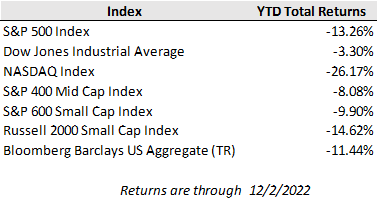U.S. equity markets continued to push higher, largely buoyed by Fed Chair Powell’s speech this past week. On Wednesday, Powell noted that moderating the pace of rate hikes could come as soon as December, but there is still a long way to go to restoring price stability. This was enough to send the markets strongly higher on the day and aided positive weekly gains. Bonds also rallied on the news, sending rates lower and touching yields not seen since September.
The rally in longer-dated bonds pushed their yields further below shorter-dated bonds, resulting in the largest negative spread since 1981 with the 2-year Treasury yield at 4.29% compared to the 10-year Treasury yield of 3.51%. Known as an inverted yield curve, this is often a signal seen before recessionary periods. The current yield curve is “the market saying: I think inflation is going to come down,” said Gene Tannuzzo, global head of fixed income at Columbia Threadneedle. In other words, the market is reflecting confidence in the Fed’s ability to restore price stability in the years ahead, but restrictive conditions may also inflict economic pain along the way, such as rising unemployment.
Recent inflation readings continue to confirm traction toward that end. Last week’s update of Core PCE, a favorite inflation gauge of the Fed, showed a 0.2% month-over-month increase in October, weaker than 0.3% consensus and a slowdown from the prior month's 0.5% increase. The year-over-year growth rate fell to 5.0% compared to 5.2% in September. Higher energy and gasoline prices were partly offset by widespread decreases in durable-goods pricing. Personal income and personal spending both accelerated, coming in ahead of estimates.
Meanwhile, other economic readings have provided a mixed picture on the extent of cooling economic conditions. The labor market, for example, has shown slowing job growth but remains resilient against tightening financial conditions. The November jobs report showed employers added 263,000 jobs, 63,000 higher than expected. The unemployment rate held steady at 3.7%. Notable gains were in leisure and hospitality, health care and government.
However, the manufacturing sector has been a growing pocket of weakness as consumers have shifted their spending away from goods towards services like travel, entertainment, and hospitality. November ISM manufacturing was down 1.2 points month-over-month to 49.0, falling into contraction territory for first time since May 2020. The report confirms the recent trend in waning goods demand and falling input costs from easing commodity prices that are both contributing to easing inflation pressures.
The revised third quarter GDP report also came in better than anticipated. The US economy grew at a 2.9% annual rate for Q3, following two quarters of contraction. The report noted solid gains in exports and consumer spending that was stronger than originally reported. Economists are currently expecting a 1% growth rate for Q4.


